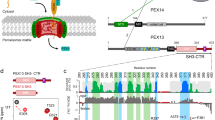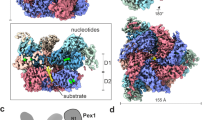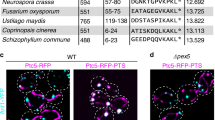Abstract
Appropriate targeting of matrix proteins to peroxisomes is mainly directed by two types of peroxisomal targeting signals, PTS1 and PTS2. Although the basis of PTS1 recognition has been revealed by structural studies, that of PTS2 recognition remains elusive. Here we present the crystal structure of a heterotrimeric PTS2-recognition complex from Saccharomyces cerevisiae, containing Pex7p, the C-terminal region of Pex21p and the PTS2 of the peroxisomal 3-ketoacyl-CoA thiolase. Pex7p forms a β-propeller structure and provides a platform for cooperative interactions with both the amphipathic PTS2 helix and Pex21p. The C-terminal region of Pex21p directly covers the hydrophobic surfaces of both Pex7p and PTS2, and the resulting hydrophobic core is the primary determinant of stable complex formation. Together with in vivo and in vitro functional assays of Pex7p and Pex21p variants, our findings reveal the molecular mechanism of PTS2 recognition.
This is a preview of subscription content, access via your institution
Access options
Subscribe to this journal
Receive 12 print issues and online access
$189.00 per year
only $15.75 per issue
Buy this article
- Purchase on Springer Link
- Instant access to full article PDF
Prices may be subject to local taxes which are calculated during checkout





Similar content being viewed by others
References
Wanders, R.J. & Waterham, H.R. Biochemistry of mammalian peroxisomes revisited. Annu. Rev. Biochem. 75, 295–332 (2006).
Platta, H.W. & Erdmann, R. Peroxisomal dynamics. Trends Cell Biol. 17, 474–484 (2007).
Ma, C., Agrawal, G. & Subramani, S. Peroxisome assembly: matrix and membrane protein biogenesis. J. Cell Biol. 193, 7–16 (2011).
Steinberg, S.J. et al. Peroxisome biogenesis disorders. Biochim. Biophys. Acta 1763, 1733–1748 (2006).
Stanley, W.A. et al. Recognition of a functional peroxisome type 1 target by the dynamic import receptor pex5p. Mol. Cell 24, 653–663 (2006).
Gatto, G.J. Jr., Geisbrecht, B.V., Gould, S.J. & Berg, J.M. Peroxisomal targeting signal-1 recognition by the TPR domains of human PEX5. Nat. Struct. Biol. 7, 1091–1095 (2000).
Lazarow, P.B. The import receptor Pex7p and the PTS2 targeting sequence. Biochim. Biophys. Acta 1763, 1599–1604 (2006).
Schliebs, W. & Kunau, W.H. PTS2 co-receptors: diverse proteins with common features. Biochim. Biophys. Acta 1763, 1605–1612 (2006).
Swinkels, B.W., Gould, S.J., Bodnar, A.G., Rachubinski, R.A. & Subramani, S. A novel, cleavable peroxisomal targeting signal at the amino-terminus of the rat 3-ketoacyl-CoA thiolase. EMBO J. 10, 3255–3262 (1991).
Osumi, T. et al. Amino-terminal presequence of the precursor of peroxisomal 3-ketoacyl-CoA thiolase is a cleavable signal peptide for peroxisomal targeting. Biochem. Biophys. Res. Commun. 181, 947–954 (1991).
Petriv, O.I., Tang, L., Titorenko, V.I. & Rachubinski, R.A. A new definition for the consensus sequence of the peroxisome targeting signal type 2. J. Mol. Biol. 341, 119–134 (2004).
Marzioch, M., Erdmann, R., Veenhuis, M. & Kunau, W.H. PAS7 encodes a novel yeast member of the WD-40 protein family essential for import of 3-oxoacyl-CoA thiolase, a PTS2-containing protein, into peroxisomes. EMBO J. 13, 4908–4918 (1994).
Zhang, J.W. & Lazarow, P.B. PEB1 (PAS7) in Saccharomyces cerevisiae encodes a hydrophilic, intra-peroxisomal protein that is a member of the WD repeat family and is essential for the import of thiolase into peroxisomes. J. Cell Biol. 129, 65–80 (1995).
Braverman, N. et al. Human PEX7 encodes the peroxisomal PTS2 receptor and is responsible for rhizomelic chondrodysplasia punctata. Nat. Genet. 15, 369–376 (1997).
Motley, A.M. et al. Rhizomelic chondrodysplasia punctata is a peroxisomal protein targeting disease caused by a non-functional PTS2 receptor. Nat. Genet. 15, 377–380 (1997).
Purdue, P.E., Zhang, J.W., Skoneczny, M. & Lazarow, P.B. Rhizomelic chondrodysplasia punctata is caused by deficiency of human PEX7, a homologue of the yeast PTS2 receptor. Nat. Genet. 15, 381–384 (1997).
Elgersma, Y. et al. A mobile PTS2 receptor for peroxisomal protein import in Pichia pastoris. J. Cell Biol. 140, 807–820 (1998).
Mukai, S., Ghaedi, K. & Fujiki, Y. Intracellular localization, function, and dysfunction of the peroxisome-targeting signal type 2 receptor, Pex7p, in mammalian cells. J. Biol. Chem. 277, 9548–9561 (2002).
Nito, K., Hayashi, M. & Nishimura, M. Direct interaction and determination of binding domains among peroxisomal import factors in Arabidopsis thaliana. Plant Cell Physiol. 43, 355–366 (2002).
Sichting, M., Schell-Steven, A., Prokisch, H., Erdmann, R. & Rottensteiner, H. Pex7p and Pex20p of Neurospora crassa function together in PTS2-dependent protein import into peroxisomes. Mol. Biol. Cell 14, 810–821 (2003).
Rehling, P. et al. The import receptor for the peroxisomal targeting signal 2 (PTS2) in Saccharomyces cerevisiae is encoded by the PAS7 gene. EMBO J. 15, 2901–2913 (1996).
Glover, J.R., Andrews, D.W., Subramani, S. & Rachubinski, R.A. Mutagenesis of the amino targeting signal of Saccharomyces cerevisiae 3-ketoacyl-CoA thiolase reveals conserved amino acids required for import into peroxisomes in vivo. J. Biol. Chem. 269, 7558–7563 (1994).
Braverman, N. et al. Mutation analysis of PEX7 in 60 probands with rhizomelic chondrodysplasia punctata and functional correlations of genotype with phenotype. Hum. Mutat. 20, 284–297 (2002).
Motley, A.M. et al. Mutational spectrum in the PEX7 gene and functional analysis of mutant alleles in 78 patients with rhizomelic chondrodysplasia punctata type 1. Am. J. Hum. Genet. 70, 612–624 (2002).
Kunze, M. et al. Structural requirements for interaction of peroxisomal targeting signal 2 and its receptor PEX7. J. Biol. Chem. 286, 45048–45062 (2011).
Purdue, P.E., Yang, X. & Lazarow, P.B. Pex18p and Pex21p, a novel pair of related peroxins essential for peroxisomal targeting by the PTS2 pathway. J. Cell Biol. 143, 1859–1869 (1998).
Einwächter, H., Sowinski, S., Kunau, W.H. & Schliebs, W. Yarrowia lipolytica Pex20p, Saccharomyces cerevisiae Pex18p/Pex21p and mammalian Pex5pL fulfil a common function in the early steps of the peroxisomal PTS2 import pathway. EMBO Rep. 2, 1035–1039 (2001).
Léon, S. et al. Dynamics of the peroxisomal import cycle of PpPex20p: ubiquitin-dependent localization and regulation. J. Cell Biol. 172, 67–78 (2006).
Khan, B.R. & Zolman, B.K. Pex5 mutants that differentially disrupt PTS1 and PTS2 peroxisomal matrix protein import in Arabidopsis. Plant Physiol. 154, 1602–1615 (2010).
Braverman, N., Dodt, G., Gould, S.J. & Valle, D. An isoform of pex5p, the human PTS1 receptor, is required for the import of PTS2 proteins into peroxisomes. Hum. Mol. Genet. 7, 1195–1205 (1998).
Otera, H. et al. Peroxisome targeting signal type 1 (PTS1) receptor is involved in import of both PTS1 and PTS2: studies with PEX5-defective CHO cell mutants. Mol. Cell. Biol. 18, 388–399 (1998).
Matsumura, T., Otera, H. & Fujiki, Y. Disruption of the interaction of the longer isoform of Pex5p, Pex5pL, with Pex7p abolishes peroxisome targeting signal type 2 protein import in mammals: study with a novel Pex5-impaired Chinese hamster ovary cell mutant. J. Biol. Chem. 275, 21715–21721 (2000).
Dodt, G., Warren, D., Becker, E., Rehling, P. & Gould, S.J. Domain mapping of human PEX5 reveals functional and structural similarities to Saccharomyces cerevisiae Pex18p and Pex21p. J. Biol. Chem. 276, 41769–41781 (2001).
Léon, S. & Subramani, S. A conserved cysteine residue of Pichia pastoris Pex20p is essential for its recycling from the peroxisome to the cytosol. J. Biol. Chem. 282, 7424–7430 (2007).
Hensel, A. et al. Cysteine-dependent ubiquitination of Pex18p is linked to cargo translocation across the peroxisomal membrane. J. Biol. Chem. 286, 43495–43505 (2011).
Neufeld, C. et al. Structural basis for competitive interactions of Pex14 with the import receptors Pex5 and Pex19. EMBO J. 28, 745–754 (2009).
Smith, T.F., Gaitatzes, C., Saxena, K. & Neer, E.J. The WD repeat: a common architecture for diverse functions. Trends Biochem. Sci. 24, 181–185 (1999).
Wall, M.A. et al. The structure of the G protein heterotrimer Giα1β1γ2 . Cell 83, 1047–1058 (1995).
Couture, J.F., Collazo, E. & Trievel, R.C. Molecular recognition of histone H3 by the WD40 protein WDR5. Nat. Struct. Mol. Biol. 13, 698–703 (2006).
Janda, C.Y. et al. Recognition of a signal peptide by the signal recognition particle. Nature 465, 507–510 (2010).
Abe, Y. et al. Structural basis of presequence recognition by the mitochondrial protein import receptor Tom20. Cell 100, 551–560 (2000).
Baker, N.A., Sept, D., Joseph, S., Holst, M.J. & McCammon, J.A. Electrostatics of nanosystems: application to microtubules and the ribosome. Proc. Natl. Acad. Sci. USA 98, 10037–10041 (2001).
Wu, S. & Letchworth, G.J. High efficiency transformation by electroporation of Pichia pastoris pretreated with lithium acetate and dithiothreitol. Biotechniques 36, 152–154 (2004).
Battye, T.G., Kontogiannis, L., Johnson, O., Powell, H.R. & Leslie, A.G. iMOSFLM: a new graphical interface for diffraction-image processing with MOSFLM. Acta Crystallogr. D Biol. Crystallogr. 67, 271–281 (2011).
Winn, M.D. et al. Overview of the CCP4 suite and current developments. Acta Crystallogr. D Biol. Crystallogr. 67, 235–242 (2011).
McCoy, A.J. et al. Phaser crystallographic software. J. Appl. Crystallogr. 40, 658–674 (2007).
Perrakis, A., Morris, R. & Lamzin, V.S. Automated protein model building combined with iterative structure refinement. Nat. Struct. Biol. 6, 458–463 (1999).
Emsley, P. & Cowtan, K. Coot: model-building tools for molecular graphics. Acta Crystallogr. D Biol. Crystallogr. 60, 2126–2132 (2004).
Murshudov, G.N., Vagin, A.A. & Dodson, E.J. Refinement of macromolecular structures by the maximum-likelihood method. Acta Crystallogr. D Biol. Crystallogr. 53, 240–255 (1997).
Chen, V.B. et al. MolProbity: all-atom structure validation for macromolecular crystallography. Acta Crystallogr. D Biol. Crystallogr. 66, 12–21 (2010).
Krissinel, E. & Henrick, K. Inference of macromolecular assemblies from crystalline state. J. Mol. Biol. 372, 774–797 (2007).
Baudin, A., Ozier-Kalogeropoulos, O., Denouel, A., Lacroute, F. & Cullin, C. A simple and efficient method for direct gene deletion in Saccharomyces cerevisiae. Nucleic Acids Res. 21, 3329–3330 (1993).
Gietz, R.D. & Schiestl, R.H. Frozen competent yeast cells that can be transformed with high efficiency using the LiAc/SS carrier DNA/PEG method. Nat. Protoc. 2, 1–4 (2007).
Acknowledgements
We thank H. Hirai for helpful advice on plasmid construction, protein purification and crystallization. We thank Y. Matsuura for critical reading of the manuscript. This work was supported by the Targeted Proteins Research Program of the Ministry of Education, Culture, Sports, Science, and Technology, Japan (H.K.). The synchrotron radiation experiments were performed at SPring-8 BL41XU (2011A1210, 2011A1289).
Author information
Authors and Affiliations
Contributions
D.P. generated plasmids, proteins and crystals. D.P. and T.N. collected diffraction data and solved the structure. D.P. performed pulldown experiments and in vivo functional assays. H.K. supervised the project. D.P. and H.K. wrote the paper.
Corresponding authors
Ethics declarations
Competing interests
The authors declare no competing financial interests.
Supplementary information
Supplementary Text and Figures
Supplementary Figures 1–5, Supplementary Tables 1 and 2, and Supplementary Note (PDF 1429 kb)
Rights and permissions
About this article
Cite this article
Pan, D., Nakatsu, T. & Kato, H. Crystal structure of peroxisomal targeting signal-2 bound to its receptor complex Pex7p–Pex21p. Nat Struct Mol Biol 20, 987–993 (2013). https://doi.org/10.1038/nsmb.2618
Received:
Accepted:
Published:
Issue Date:
DOI: https://doi.org/10.1038/nsmb.2618
This article is cited by
-
Peroxisomal compartmentalization of amino acid biosynthesis reactions imposes an upper limit on compartment size
Nature Communications (2023)
-
A missense allele of PEX5 is responsible for the defective import of PTS2 cargo proteins into peroxisomes
Human Genetics (2021)
-
Current Advances in Protein Import into Peroxisomes
The Protein Journal (2019)
-
Chemically monoubiquitinated PEX5 binds to the components of the peroxisomal docking and export machinery
Scientific Reports (2018)
-
Design of an expression system to enhance MBP-mediated crystallization
Scientific Reports (2017)



